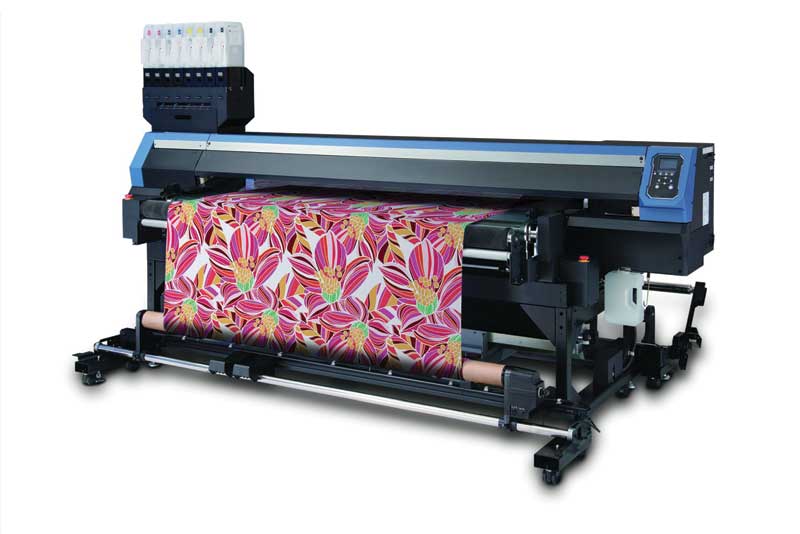Wide-format Printing: Why standardized testing matters for printed textiles
by all | 29 March 2018 3:24 pm
 [1]
[1]Photo courtesy Roland DGA
By Diana Wyman
Many of the products people use every day are tested and certified for safety, quality and regulatory compliance. As such, there are standardized tests for everything from power cords to art supplies. They are critically important for making valid comparisons between (a) different lots of the same product or (b) rival products of the same type. The results can be used to promote the key features of a product or to compare them with those of its competitors.
In some cases, the criteria for these tests are mandated by law, while in others, they are simply agreed upon between buyers and sellers of the products in question. Either way, standardized testing provides a common language for communication between various parties, with a passing grade providing confidence to them in a smooth transaction.
Standardized tests are vital to the wide-format printing industry, as well, particularly with respect to new and increasingly commonly used materials, such as textiles intended for graphic applications.
Impartiality
According to the World Trade Organization (WTO), the primary principles for developing an international standard are transparency, openness, impartiality and consensus. This means multiple perspectives need to be considered.
Test methods developed by a single person or company can end up with intentional or unintentional biases. Standardized test methods, on the other hand, are developed specifically to be fair and unbiased, with a variety of manufacturers, buyers, researchers and users from across the corresponding industry providing input.
Standards developing organizations (SDOs) ensure this process allows everyone the opportunity to comment and offer suggestions. Their committees are generally open to all interested parties. While a small task force may be put together to draft a new or revised testing method, the entire committee votes on the results at the end of the process.
Indeed, in many SDOs, every voice is heard; even if only one out of 100 members votes against an item, the group must consider that voter’s position. An individual is not simply overruled by the majority.
Collaboration
The co-operative efforts of industry stakeholders have advantages beyond promoting fair trade between them. Standardized testing also benefits from the collective knowledge of numerous industry experts, with a variety of perspectives leading to a more robust test method. What one person misses, a team can catch.
While an industry as a whole benefits from better methods, individual companies operating within it will also benefit from distribution of the work involved in test development. Some large organizations can support internal test method development, but their resources can go even farther by working with others on multiple projects, while small organizations that cannot afford the time or funding for independent test method development can play an important role in collaborative development.
 [2]
[2]Tests should confirm weather resistance for fabrics that will be used outdoors.
Photo courtesy Expand A Sign
Verification
SDOs do not only rely on the opinions of experts. To make sure the theories behind a new testing method are valid, the method must itself be tested.
Interlaboratory studies are undertaken to ensure each test method provides repeatable and reproducible results. By having multiple operators in multiple labs perform the same procedure, these studies can identify potential areas for improvement or clarification.
Interlaboratory studies are also used to develop statistics regarding just how consistent the results are likely to be. With this information, a company can make better-educated decisions about selecting a testing method, the number of specimens to test and when to retest them.
Updates
Consistency is key, but standards are not static documents. After a standard is published, experts continue to come together to review it on a regular basis. Its wording might be revised to reduce confusion or a procedure may be updated to allow for a new technology. And occasionally, a better method of testing is discovered.
As with the initial testing method development process, updates are more efficient and more thorough when there is a team in place to share ideas and work. Also, revisions need to be carefully tracked, so there is no confusion about which version of a method is being referenced. There is usually documentation to show exactly which changes were made with each revision.
Testing textiles
The ongoing development of standardized test methods for textiles used in wide-format printing is a worthwhile investment, but can seem overwhelming, as each material requires a slightly different battery of tests depending on its components, production process and specific end use. Overall, though, a few basic categories are of particular importance:
Health and safety
Health and safety tests are often required by law. Even when they are not, they are vital both for ensuring products are satisfactory and for avoiding costly recalls or lawsuits.
Also, health and safety regulations are constantly changing. They vary among countries and even among provinces and states.
With textiles, the applicable flammability and chemical standards will need to be identified for testing. Chemical exposure must be considered both for those involved in manufacturing processes and those using the materials in finished applications.
 [3]
[3]Standardized testing is important given the development of new textiles for wide-format printing.
Photo courtesy Mimaki
Colourfastness
Colourfastness is the resistance of a material to (a) change in any of its colour characteristics and/or (b) transfer of its colourants to adjacent materials, as a result of the exposure of the material to any environment that might be encountered during the processing, testing, storage or use of that material.
Examples of such environmental exposure can include light, laundering, rubbing, chemicals, heat and other conditions, any of which may cause an unwanted change or transfer of colour.
Colourfastness to crocking (i.e. dry or wet rubbing) is especially relevant to today’s printed textiles. With most types of digital wide-format printing, colour is applied mainly to the surface of the material, where it can prove more fugitive than a dye that is completely absorbed by the fibres (as is the case with dye sublimation).
In a crocking test, a white cloth is rubbed on the surface of the test fabric. As in any laboratory test method, the variables must be controlled as tightly as possible.
The white cloth is meticulously specified in terms of its fibre, yarn and fabric construction. The rubbing motion is also clearly defined in terms of surface area, pressure and stroke length, as each test should be performed in exactly the same manner.
Crocking is performed with both dry and wet cloths. In each instance, the white cloth is evaluated to determine how likely the printing inks are to transfer onto another surface. This test can also evaluate colour loss of the printed material due to rubbing.
Weather resistance
Weathering should be a significant component of any testing program for products that will spend a majority of their time outdoors, as is the case with much printed signage.
Colourfastness is one aspect of weather resistance. Tests should confirm the colour does not fade prematurely due to wind, rain, sunlight or atmospheric contaminants.
Tests must also confirm the structural integrity of the material will remain intact and not become brittle or weak with outdoor exposure. Further, ultraviolet (UV) radiation and mould can pose serious challenges for some textile-based materials.
 [4]
[4]As with the inks used in wide-format printing, the chemical exposure relating to textiles is an important concern for those using the materials in finished applications, particularly indoors.
Photo courtesy LexJet
Claim verification
If a product is advertised or sold based on a specific performance feature, then it is important to back up these statements with meaningful, standardized test results. Sign shop owners and other professionals are increasingly savvy and suspicious of promotional rhetoric. A test result is more powerful than empty claims of a textile’s stain resistance or reflectivity.
The same is true of comparisons to a competitor’s product. All companies can say their products are the best, but only standardized test results can provide quantifiable evidence.
Next steps
Today, with many new textiles continuing to be introduced for the digital wide-format printing sector, standardized testing plays an important role in overall quality control and in further research and development (R&D). If signmakers get involved with the relevant SDOs, then they can help ensure their own interests are represented as new methods are developed. By being part of the process, they will also get a ‘sneak peek’ at the types of standards their customers may demand they comply with in the near future.
This is the time to (a) take advantage of the resources offered by SDOs and other players in the industry and (b) propose ideas and work with others to turn them into reality. By working together, the industry can increase the chances of developing better methods than any one party could accomplish on its own.
Diana Wyman is technical director for the American Association of Textile Chemists and Colorists (AATCC). This article is based on a seminar she presented in October at the Specialty Graphic Imaging Association’s (SGIA’s) 2017 Expo in New Orleans, La. For more information, visit www.aatcc.org[5] and www.sgia.org[6].
- [Image]: https://www.signmedia.ca/wp-content/uploads/2018/03/Rolandfabrics.jpg
- [Image]: https://www.signmedia.ca/wp-content/uploads/2018/03/expandasign.jpg
- [Image]: https://www.signmedia.ca/wp-content/uploads/2018/03/Mimakiprinter1.jpg
- [Image]: https://www.signmedia.ca/wp-content/uploads/2018/03/lexjet.jpg
- www.aatcc.org: http://www.aatcc.org
- www.sgia.org: http://www.sgia.org
Source URL: https://www.signmedia.ca/wide-format-printing-why-standardized-testing-matters-for-printed-textiles/